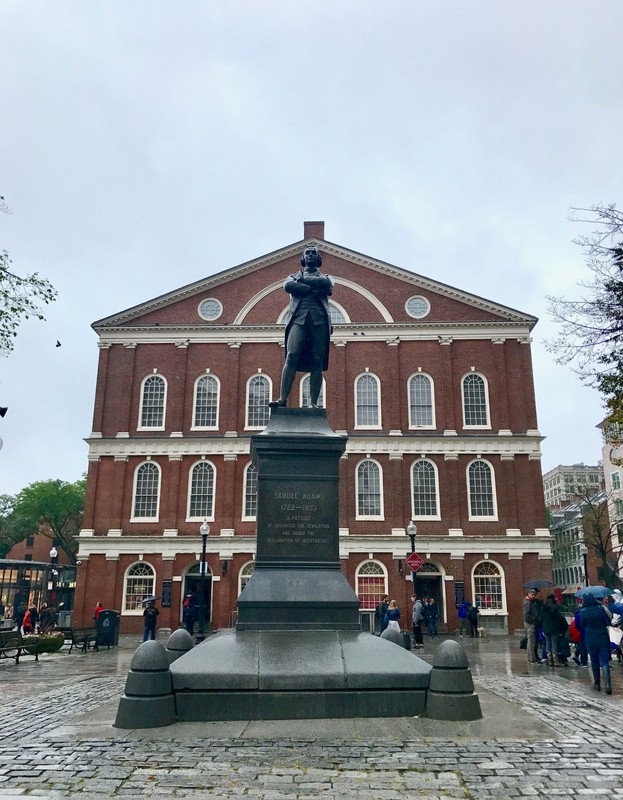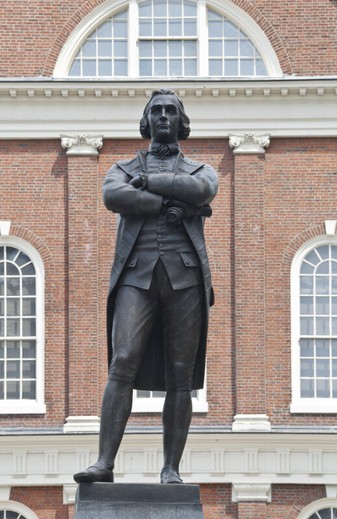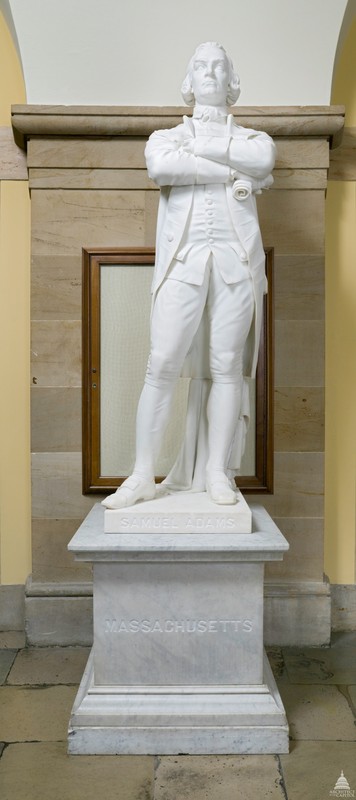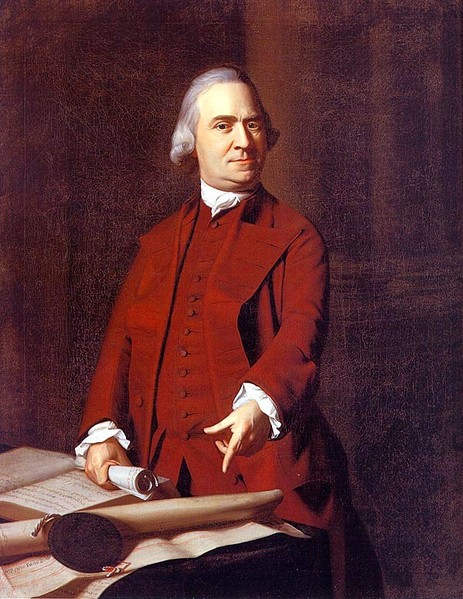Samuel Adams Statue
Introduction
Text-to-speech Audio
This statue commemorates Founding Father, Samuel Adams (1722-1803). A native of Boston and graduate of Harvard College, he became an early proponent of American independence from Great Britain and one of the leaders of the Sons of Liberty. A signer of the Declaration of Independence, Adams served in the Massachusetts House of Representatives (1765-1774) and the Continental Congress (1774-1781) before becoming lieutenant governor (1789-1794) and then governor of Massachusetts (1793-1797). In 1873, the Commonwealth of Massachusetts commissioned sculptor Anne Whitney to design a statue of Adams for inclusion in National Statuary Hall within the U.S. Capitol. Made of Carrera marble, the sculpture was installed in 1876. A few years later, the City of Boston commissioned a bronze casting of the statue. Dedicated in 1880, the sculpture depicts Adams standing defiantly with his arms crossed and a scroll of papers in his right hand. Dressed in period clothing, he looks out into the distance. The statue rests on a tall pedestal made of Quincy granite. Originally installed in the city’s Adams Square, it now resides on Congress Street near Faneuil Hall.
Images
Samuel Adams Statue with Faneuil Hall in the background

A closer look at the bronze sculpture

Whitney's original marble statue in the U.S. Capitol

Samuel Adams (1722-1803)

Backstory and Context
Text-to-speech Audio
Samuel Adams was born into a wealthy Boston family on September 27, 1722. His father was a successful merchant and Congregationalist deacon who was deeply involved in local politics. A second cousin of John Adams, Samuel Adams attended Boston Latin School before enrolling at Harvard College, where he read and became influenced by the writings of English philosopher and political theorist John Locke. After graduating with a bachelor’s degree in 1740, he decided to continue his studies at Harvard and earned a master’s degree three years later. Adams then briefly studied law before taking over the family malt-making business upon the death of his father in 1748. Lacking a strong business acumen, he eventually went bankrupt. Likewise, the Harvard graduate later proved himself to be a lousy tax collector.
Adams did, however, possess a strong interest in politics and a knack for writing. In the same year that his father passed away, he and some of his friends established a newspaper, The Public Advertiser. During its short run, the publication featured a number of political essays written by Adams, in which instructed Bostonians to appreciate their rights and safeguard them against infringement. In the wake of the Seven Years War (1756-1763), as Great Britain attempted to pay down the debt it incurred during the conflict by imposing new taxes on the American colonists, Adams became a vocal critic of British imperial policy. By taxing the colonists, he argued, Great Britain was violating their rights, since they lacked actual representation in Parliament. Following the passage of the Stamp Act in 1765, Adams helped precipitate violent resistance to the revenue-raising measure. That same year, he won election to the Massachusetts House of Representatives, ultimately serving for nearly a decade. Also around this time, Adams joined a secret society that evolved into the Sons of Liberty, and eventually became one of its leaders. While he did not take part in the Boston Tea Party in December 1773, he most certainly helped plan it. Adams then served as a delegate to the Continental Congress and was one of the fifty-six men who signed the Declaration of Independence in the summer of 1776. Later, he also signed and helped draft the Articles of Confederation, the first form of national government for the United States.
When his time in the Continental Congress came to an end in 1781, Adams returned to Massachusetts, where he continued to be politically active at the state level. In 1789, he became the lieutenant governor of Massachusetts. Upon the death of Governor John Hancock in October 1793, Adams became acting governor. The following year, he won election in his own right, ultimately serving in the office until 1797. Six years later, Adams died in Boston on October 2, 1803 at the age of eighty-one. His remains were interred in the city’s Granary Burial Ground.
In 1873, the Commonwealth of Massachusetts commissioned sculptor Anne Whitney to design a statue of Adams for inclusion in National Statuary Hall within the U.S. Capitol. Made of Carrera marble, the sculpture was installed in 1876. A few years later, the City of Boston commissioned a bronze casting of the statue. Dedicated in 1880, the sculpture depicts Adams standing defiantly with his arms crossed and a scroll of papers in his right hand. Dressed in period clothing, he looks out into the distance. The statue rests on a tall pedestal made of Quincy granite. Originally installed in the city’s Adams Square, it now resides on Congress Street near Faneuil Hall.
Sources
"Adams, Samuel (1722-1803)." Biographical Directory of the United States Congress, 1774-Present. United States Congress. Web. 2 June 2021 <https://bioguideretro.congress.gov/Home/MemberDetails?memIndex=A000045>.
Heller, Jules and Nancy G. Heller, eds. North American Women Artists of the Twentieth Century: A Biographical Dictionary. New York: Routledge, 2013.
History.com Editors. "Samuel Adams." History. A&E Television Networks. 15 April 2021. Web. 2 June 2021 <https://www.history.com/topics/american-revolution/samuel-adams>.
"Samuel Adams." aoc.gov. Architect of the Capitol. Web. 2 June 2021 <https://www.aoc.gov/explore-capitol-campus/art/samuel-adams>.
"Samuel Adams." Encyclopædia Britannica. Web. 2 June 2021 <https://www.britannica.com/biography/Samuel-Adams>.
https://commons.wikimedia.org/wiki/File:Faneuil_Hall_and_Samuel_Adams_Monument.jpg
https://etc.usf.edu/clippix/picture/samuel-adams-statue-4.html
https://www.aoc.gov/explore-capitol-campus/art/samuel-adams
https://en.wikiquote.org/wiki/Samuel_Adams
